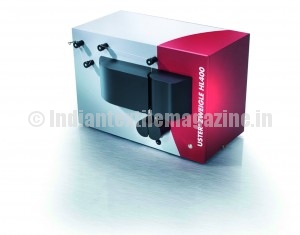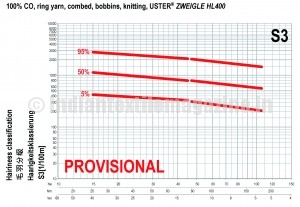The new 2013 edition of Uster Statistics, the only globally-accepted benchmarks for textiles, has just been launched with an improved online interface. Users can forecast exactly how a yarn will perform throughout the processing sequence for any given application by matching the yarn quality parameters against Uster Statistics values. That means Uster Statistics are more than just benchmarks – they are vital guidelines for production excellence along the entire textile chain.

The new Uster Statistics 2013 online tool at uster.com (see Uster Statistics under the ‘Service’ tab) now offers notable improvements, with extra features and additional yarn styles and parameters included in the wide range of Uster’s global benchmarks. Of special interest for mills producing yarns for knitted fabrics are the quality parameters for hairiness.
For the first time, the new Uster Statistics include S3 hairiness measurements: this is the global quality parameter – for ring and compact yarns – referring to the number of fibers protruding by 3 mm and more. This breakthrough was achieved with the launch in June 2010 of the Uster Zweigle HL400, taking S3 hairiness classification to the next level. This instrument offers improved accuracy and now operates at test speeds of 400 m/min. With a statistical variation of less than 10%, the Uster Zweigle HL400 allows Uster Technologies to include the critical S3 values in Uster Statistics.
Precise analysis of yarn hairiness is vital for many textile applications, as hairiness has a significant influence on both the appearance and durability of fabrics. Experience with textile fabrics has shown that 15 per cent of unacceptable fabric defects such as pilling are caused by high levels of hairiness or hairiness variations.
Yarns with higher hairiness levels also tend to generate more fly in the knitting machine, affecting its performance by causing stops and breaks, as well as fabric defects. Both vertical knitting mills and independent spinners should take note that yarns with high S3 levels are likely to impact on fabric appearance and durability, as well as on the productivity and efficiency of subsequent processing stages. The negative impact of high hairiness levels on productivity is also likely to generate a large number of complaints.

Elongation in practice
Mills producing yarns for weaving require other essential quality parameters. In weaving, yarn strength and elongation are very important yarn characteristics, as also is the degree of variation in these characteristics.
Yarn producers need to keep in mind, for example, that the loss of elongation during sizing varies from at least 0.6 per cent for a ring-spun cotton yarn to 1.5 per cent for an OE cotton yarn, even with ideal sizing machine settings. Residual elongation is important, because during weaving each warp end has to withstand, in most cases, well over a thousand cycles of extension and relaxation, during which no breaks should happen. To keep warp breaks within acceptable levels, the residual elongation after sizing should never be lower than 3 to 4 per cent. This difference in performance is exactly reflected in the USP levels. In this specific example, the 25 per cent level in elongation is expected to behave much better than the 90 per cent level, in terms of performance for warping.
The elongation values shown in Uster Statistics are measured by the Uster Tensojet 4, which has the testing power to forecast yarn performance accurately. It measures tensile strength over 100,000 breaks, at a rate of 30,000 breaks per hour. That means it can detect yarn faults or isolated weak places. The Uster Tensojet 4 is clearly essential for testing yarns for weaving, where stresses are great.

The impact that quality parameters will have on applications, such as the level of protruding fiber significantly influencing the pilling effect, can be described simply and precisely using Uster Statistics. Therefore, data such as S3 hairiness, elongation levels and other quality parameters are vital and thus should be defined beforehand in yarn profiles and used as the basis for buying and selling of yarns.
Defining quality parameters based on Uster Statistics is akin to using a common language to define precise quality factors along the entire production chain, heightening the understanding between producers and users. This underlines the importance of Uster Statistics in understanding and communicating the quality of yarns being traded, as benchmarks, and so much more besides…
The Uster Group is the leading high-technology instrument manufacturer of products for quality measurement and certification for the textile industry. It provides testing and monitoring instruments, systems and services that allow optimization of quality through each individual stage of textile production. This includes raw textile fibers, such as cotton or wool, all staple fiber and filament yarns, as well as downstream services to the final finished fabric.
The Uster Group provides benchmarks that are a basis for the trading of textile products at assured levels of quality across global markets. The group’s aim is to forward knowhow on quality, productivity and cost to the textile industry.
Headquartered in Uster, Switzerland, the group operates through a worldwide market organization complemented by technology centers. It has sales and service subsidiaries in the major textile markets and technology centers in Uster, Knoxville (USA) and Suzhou (China).